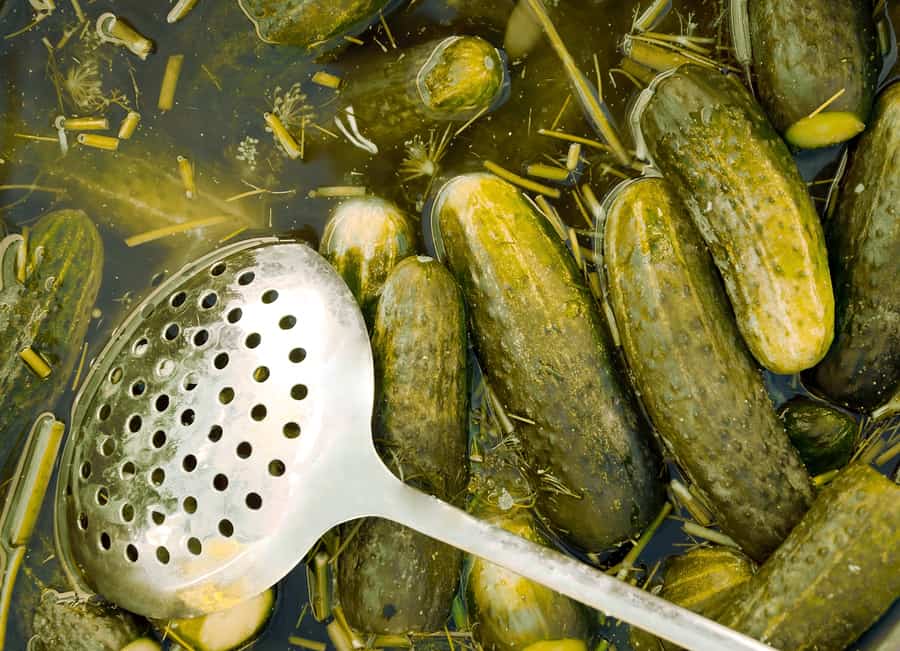
You can turn cucumbers into pickles in about 40 minutes. It’s not difficult.
My favorite pickling cucumbers are County Fair, National Pickling, Pickle Bush, Regal, and Saladin. Pickling cucumbers are short–4 inches is about the right length–and compact with tender skins. Longer, larger cucumbers such as Marketmore and Bush Champion are best for fresh eating, not pickling.
For the best pickles, choose cucumbers that are free of blemishes and undamaged. Cucumbers prime for pickling are harvested not more than 24 hours in advance. If you hold off pickling for more than a day, your pickles will become hollow in the center during processing.
Just ripe cucumbers are best. If your cucumbers are very firm or not ripe, you will want to cook them longer so that the brine can permeate the centers. (Pickles that float to the top of the jar have not been fully cooked.)
A note on vinegar used in pickling: white vinegar will result in lighter colored pickles; cider vinegar or herb-flavored vinegar will yield a richer flavor but will darken the pickles.
A note on dill and spices: fresh dill and spices will give your pickles the best flavor; ground spices and old spices will impart a dusty flavor.
Dill Pickles
Yield 5 quarts
Ingredients
- 5½ cups water
- 3½ cups white or champagne vinegar
- 1 tablespoon pickling or kosher salt
- 1 tablespoon sugar for tart pickles; 2 tablespoons of sugar for a sweeter pickle
- 5 teaspoons dill seeds
- 10 dill sprigs
- 5 garlic cloves
- 2 allspice berries (optional--see recipe)
- 25 pickling cucumbers blossom end trimmed (each cuke about 4 inches long)
Instructions
- Rinse cucumbers thoroughly under running water to remove any dirt and drain. Trim the stem to about ⅛ to ¼ inch and slice away the blossom end of each cucumber (trimming the blossom end will keep the cucumbers from going soft). Each cucumber should be about 1 inch shorter than the canning jar. If you like, quarter each cuke lengthwise for dill spears or cut crosswise into ¼–inch rounds for hamburger pickles.
- Using dill seeds: Toast the seeds until fragrant in a dry sauté pan over medium heat, about 1 minute; you will want 1 teaspoon of dill seeds for each quart. Using fresh dill florets: Snip dill florets from plants leaving the stems just long enough to fit into each jar. You’ll need 2 or 3 florets per quart jar.
- Scald the canning jars in a pot of boiling water. It’s easiest if you use a pot fitted with a jar rack. Soak the lids in hot water to soften the rubber seals.
- Add 1 teaspoon of dill seeds or 2 or 3 sprigs of dill to each quart jar before adding cucumbers. Optional: Spice these pickles up by adding 1 clove of garlic to each jar and 2 allspice berries to each jar. (You can par blanch the garlic in advance—meaning to place the cloves in a saucepan of water and bring to a boil for 2 minutes–to bring out the full flavor.)
- Pack 5 cucumbers loosely into the hot, sterilized quart jars.
- In a large stainless steel pot or nonstick saucepan combine water, vinegar, pickling salt, and sugar. Bring the mix to a boil over high heat, stirring constantly, until sugar and salt are dissolved. Reduce heat and simmer gently, stirring occasionally for 15 minutes until the brine is ready. Sweet and spicy dill pickles option: Use cider vinegar instead of white vinegar; add 2 hot chile peppers, seeded and minced to the to vinegar mixture. When adding dill to each jar also add to each jar ½ tablespoon mustard seeds, 1 bay leaf, ½ tablespoon black peppercorns, and 1 clove garlic halved.
- Pour or ladle the hot brine over the cucumbers leaving a bit less than ½ inch headspace from the rim of the jar. (You can transfer the brine to a heat-proof pitcher to pour over the cucumbers if that will make it easier.) Run a thin non-metallic utensil around the inside of the jar checking for air pockets and allowing air to escape; add more brine if necessary.
- Wipe the jar rims with a clean towel, set the lid in place then screw on the metal ring until snug not tight.
- Return the jars to the rack and place the jars in the hot water pot (bath) and add enough water to cover the now lidded jars by about 1 inch. Bring the water to a boil and process the jars for 15 minutes--20 minutes at an altitude of 1,000 to 6,000 feet; 25 minutes at an altitude above 6,000 feet (start the timer when the water reaches a boil). After turning off the heat and leave the jars in the water for a few minutes.
- Remove the jars from the water and let cool completely on the rack or a folded kitchen towel.
- Check the seals, label the jars. Store the jars in a cool place. The pickles will keep for up to 1 year.
Notes
Allow about 1 week before optimal pickle flavors develop.



